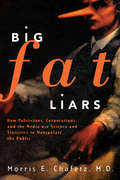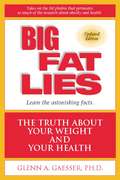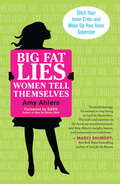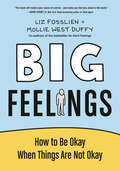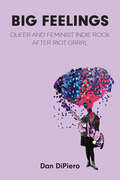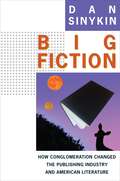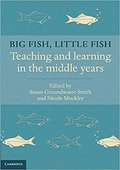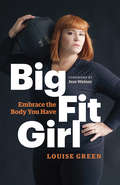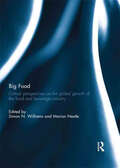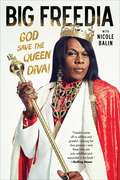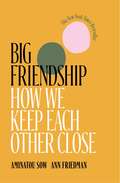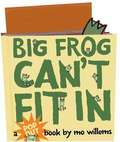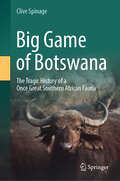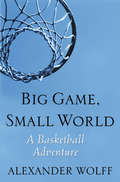- Table View
- List View
Big Fat Liars
by Morris ChafetzThese days, you can't turn on a television without hearing that you're probably fat, engaged in unhealthy behavior, failing to get sufficient exercise, destroying the environment through the use of practically every product that makes your life more convenient, and likely to fall victim to just about everything and everyone around you. But not only are the statistics that prove these points based on false information, much of our national dialogue is dictated by this patently bad science-encouraged solely by public and private organizations that leverage these demonstrably untrue facts to bolster their own philosophies and fatten their own pocketbooks. With mounds of solid evidence that contradicts common thought, Morris Chafetz shows the lies behind the facts about today's big issues (for instance, the "obesity epidemic" we hear so much about is the result not of a fatter population but instead a change in bookkeeping in a federal agency, and the evidence used now to frighten us about "global warming" was used a generation ago to frighten us about "global cooling") and encourages readers to look through the money-motivated façade of statistics and government controls and return to a strong attitude of personal responsibility.
Big Fat Lies
by Ph.D. Glenn A. Gaesser Steven N. BlairDo you believe that your weight should be within the range recommended by one of the various height-weight tables that are always appearing in books and magazines? That being overweight is unhealthy? That weight loss improves health?Have you ever been told by your doctor to lose weight? Are you currently dieting or contemplating going on a diet? Have diets failed you or made you feel like a failure? Do you feel people look down on you because of your weight? If the answer to any of these questions is "yes," then this book is for you.Millions of Americans stigmatized as "too fat" need to be reassured that the roads to good health are wide enough for everyone. Here's proof that people can be overweight and still be fit and healthy. Glenn Gaesser, an exercise physiologist, challenges the conventional wisdom that excess body fat poses a danger to health. This is an authoritative, clearly written book that is crucial reading for anyone who wants to take concrete steps towards improving their health - no matter what their size.
Big Fat Lies Women Tell Themselves: Ditch Your Inner Critic and Wake Up Your Inner Superstar
by Amy AhlersMost women have a nonstop chorus of criticism in their heads — voices not unlike those of the mean girls lurking in the hallways and locker rooms of junior high schools everywhere. The grown-up versions of those teenage taunts — such as “But taking care of myself is sel?sh” and “The world is against me” — zap motivation, sabotage happiness, and keep women in a stressed, “never enough” mind-set. Here, like a best buddy and street-wise big sister, coach Amy Ahlers helps women talk back. Her witty, wise, and cut-to-the-chase format arms women with the “Take that!” insights they wish they had handy when someone puts them down — even if that someone is the person in the mirror. Ahlers doesn’t offer long-winded self-therapy or simplistic happy talk; she serves up straight talk that helps women know, feel, and tell themselves the truths that can transform their deepest inner thoughts — and their lives.
Big Fat Negative: The Essential Guide to Infertility, IVF and the Trials of Trying for a Baby
by Emma Haslett Gabby Griffith'This book is totally brilliant - informative, sensitive, funny and wise. Reading it is like talking to a fairy godmother who also happens to be a gynaecologist and expert on all things fertility' Sophia Money-CouttsBig Fat Negative (BFN) - a term commonly used on internet forums to refer to a negative pregnancy test.Infertility can be a lonely journey. One in every six couples will struggle to conceive but, despite this, many don't feel comfortable talking openly about their experiences and sharing what they are going through. As a result, they feel isolated and alone.It doesn't have to be this way. By talking, laughing and shouting about our experiences we can start to lift the cloak of shame that so often engulfs those going through it. Big Fat Negative does just that. This no-nonsense, honest guide to infertility from the hosts of the Big Fat Negative podcast smashes the taboo around this isolating and heartbreaking illness, offering first-hand experience, an understanding voice when friends don't get it, expert advice, reassurance for when you feel alone and - most importantly - humour when it you need it the most. Using first-hand accounts of the various hurdles of infertility, from work to diagnoses and IVF, coupled with advice from leading experts, Big Fat Negative will hold your hand on the not-so simple journey to motherhood - helping you to face and defeat the trials of trying for a baby.
Big Fat Negative: The Essential Guide to Infertility, IVF and the Trials of Trying for a Baby
by Emma Haslett Gabby Griffith'This book is totally brilliant - informative, sensitive, funny and wise. Reading it is like talking to a fairy godmother who also happens to be a gynaecologist and expert on all things fertility' Sophia Money-CouttsBig Fat Negative (BFN) - a term commonly used on internet forums to refer to a negative pregnancy test.Infertility can be a lonely journey. One in every six couples will struggle to conceive but, despite this, many don't feel comfortable talking openly about their experiences and sharing what they are going through. As a result, they feel isolated and alone.It doesn't have to be this way. By talking, laughing and shouting about our experiences we can start to lift the cloak of shame that so often engulfs those going through it. Big Fat Negative does just that. This no-nonsense, honest guide to infertility from the hosts of the Big Fat Negative podcast smashes the taboo around this isolating and heartbreaking illness, offering first-hand experience, an understanding voice when friends don't get it, expert advice, reassurance for when you feel alone and - most importantly - humour when it you need it the most. Using first-hand accounts of the various hurdles of infertility, from work to diagnoses and IVF, coupled with advice from leading experts, Big Fat Negative will hold your hand on the not-so simple journey to motherhood - helping you to face and defeat the trials of trying for a baby.
Big Fat Negative: The Essential Guide to Infertility, IVF and the Trials of Trying for a Baby
by Emma Haslett Gabby Griffith'This book is totally brilliant - informative, sensitive, funny and wise. Reading it is like talking to a fairy godmother who also happens to be a gynaecologist and expert on all things fertility' Sophia Money-CouttsBig Fat Negative (BFN) - a term commonly used on internet forums to refer to a negative pregnancy test.Infertility can be a lonely journey. One in every six couples will struggle to conceive but, despite this, many don't feel comfortable talking openly about their experiences and sharing what they are going through. As a result, they feel isolated and alone.It doesn't have to be this way. By talking, laughing and shouting about our experiences we can start to lift the cloak of shame that so often engulfs those going through it. Big Fat Negative does just that. This no-nonsense, honest guide to infertility from the hosts of the Big Fat Negative podcast smashes the taboo around this isolating and heartbreaking illness, offering first-hand experience, an understanding voice when friends don't get it, expert advice, reassurance for when you feel alone and - most importantly - humour when it you need it the most. Using first-hand accounts of the various hurdles of infertility, from work to diagnoses and IVF, coupled with advice from leading experts, Big Fat Negative will hold your hand on the not-so simple journey to motherhood - helping you to face and defeat the trials of trying for a baby.
Big Feelings: How to Be Okay When Things Are Not Okay
by Liz Fosslien Mollie West DuffyFrom the duo behind the bestselling book No Hard Feelings and the wildly popular @LizandMollie Instagram, an insightful and approachable illustrated guide to handling our most difficult emotions.We all experience unwieldy feelings. But between our emotion-phobic society and the debilitating uncertainty of modern times, we usually don't know how to talk about what we're going through, much less handle it. Over the past year, Liz Fosslien and Mollie West Duffy&’s online community has laughed and cried about productivity guilt, pandemic anxiety, and Zoom fatigue. Now, Big Feelings addresses anyone intimidated by oversized feelings they can't predict or control, offering the tools to understand what's really going on, find comfort, and face the future with a sense of newfound agency. Weaving surprising science with personal stories and original illustrations, each chapter examines one uncomfortable feeling—like envy, burnout, and anxiety—and lays out strategies for turning big emotions into manageable ones. You&’ll learn: • How to end the cycle of intrusive thoughts brought on by regret, and instead use this feeling as a compass for making decisions • How to identify what&’s behind your anger and communicate it productively, without putting people on the defensive • Why we might be suffering from perfectionism even if we feel far from perfect, and how to detach your self-worth from what you do Big Feelings helps us understand that difficult emotions are not abnormal, and that we can emerge from them with a deeper sense of meaning. We can&’t stop emotions from bubbling up, but we can learn how to make peace with them.
Big Feelings: Queer and Feminist Indie Rock After Riot Grrrl (Tracking Pop)
by Dan DiPieroIn the past decade, a distinctive resurgence of indie music has seen young, queer, and feminist artists reformulating the genre with strategic reappropriations of ’90s grunge and 2000s-era pop. Big Feelings offers a nuanced analysis of these musicians and the socio-political crises informing their sounds. Dan DiPiero situates this new wave of indie music within the context of the emotional sensibilities and social orientations of a young generation flattened by an endless stream of everyday traumas. Listening closely to Soccer Mommy, Indigo De Souza, Jay Som, SASAMI, The Ophelias, Vagabon, boygenius, and more, Big Feelings traces points of resonance and connection that help fans perceive politics where it might first appear absent. By bringing listeners’ experiences into the analysis, DiPiero shows how indie rock feminisms have shifted since the 1990s, rejecting overt political messages in favor of sonic catharsis, and reflecting the complex, ambivalent feeling of being young while the world burns. In reprising the sounds of an alt-rock associated in public consciousness with white male pain, Big Feelings doubles down on the stereotypical association between femininity and emotionality to perform whole spectrums of feeling in varied states of overwhelm. In doing so, these artists draw attention to overlooked histories of women and queer musicians who have been forging indie rock all along, while also remaking how the music matters in the present.
Big Fiction: How Conglomeration Changed the Publishing Industry and American Literature (Literature Now)
by Dan SinykinIn the late 1950s, Random House editor Jason Epstein would talk jazz with Ralph Ellison or chat with Andy Warhol while pouring drinks in his office. By the 1970s, editors were poring over profit-and-loss statements. The electronics company RCA bought Random House in 1965, and then other large corporations purchased other formerly independent publishers. As multinational conglomerates consolidated the industry, the business of literature—and literature itself—transformed.Dan Sinykin explores how changes in the publishing industry have affected fiction, literary form, and what it means to be an author. Giving an inside look at the industry’s daily routines, personal dramas, and institutional crises, he reveals how conglomeration has shaped what kinds of books and writers are published. Sinykin examines four different sectors of the publishing industry: mass-market books by brand-name authors like Danielle Steel; trade publishers that encouraged genre elements in literary fiction; nonprofits such as Graywolf that aspired to protect literature from market pressures; and the distinctive niche of employee-owned W. W. Norton. He emphasizes how women and people of color navigated shifts in publishing, arguing that writers such as Toni Morrison allegorized their experiences in their fiction.Big Fiction features dazzling readings of a vast range of novelists—including E. L. Doctorow, Judith Krantz, Renata Adler, Stephen King, Joan Didion, Cormac McCarthy, Chuck Palahniuk, Patrick O’Brian, and Walter Mosley—as well as vivid portraits of industry figures. Written in gripping and lively prose, this deeply original book recasts the past six decades of American fiction.
Big Fish, Little Fish
by Susan Groundwater-Smith Nicole MocklerBig Fish, Little Fish: Teaching and Learning in the Middle Years provides pre-service and early career teachers with a pathway to understanding the needs of students as they make the important transition from primary to secondary schooling. The book explores contemporary challenges for teaching and learning in the middle years, with a focus on student experience, identity, engagement and resilience. Key issues, such as teaching academically at-risk students, the impact of education policy on middle years students, and teacher preparation and identity, are given comprehensive coverage. Unique to this text is its focus on and analysis of the history of middle-years education, as well as its in-depth discussion of the experiences of young Indigenous and Māori students. Drawing on the wide-ranging expertise of its contributors, Big Fish, Little Fish prepares pre-service teachers to best meet the needs of students as they enter the challenging middle years of their education.
Big Fit Girl: Embrace the Body You Have
by Louise Green&“Finally—a fitness book for the rest of us! . . . [Big Fit Girl] is sure to usher in a new generation of tough, curvy athletes.&” —Jessamyn Stanley, author of Every Body Yoga In Big Fit Girl, Louise Green describes how the fitness industry fails to meet the needs of plus-size women and thus prevents them from improving their health and fitness. By telling her own story of how she stopped dieting, got off the couch, and unleashed her inner athlete—as well as showcasing similar stories from other women—Green inspires other plus-size women to do the same. Green also provides concrete advice, based on the latest research, about how to get started, how to establish a support team, how to choose an activity, what kind of clothing and gear work best for the plus-size athlete, how to set goals, and how to improve one&’s relationship with food. And she stresses the importance of paying it forward—for it is only by seeing plus-size women in leadership roles that other plus-size women will be motivated to stop trying to lose weight and get fit instead. &“Big Fit Girl impressed me tremendously. Green combines compelling storytelling with practical tips—true to what we know about science—in a unique way that will get you moving.&” —Linda Bacon, PhD, scientist, and author of Health at Every Size &“Inspiring and empowering.&” —Taryn Brumfitt, producer and director, founder of the Body Image Movement &“I&’m thrilled to live in a world where Big Fit Girl will be part of the health section. Thank you Louise—it&’s time for every person of every size to have access to this information!&” —Jes Baker, The Militant Baker
Big Flavors from Italian America: Family-Style Favorites from Coast to Coast
by America'S Test KitchenCelebrate the generous, comforting red sauce cooking that defines Italian America.Dig into the best of Italian American cooking with recipes that would make any nonna proud. Bubbling lasagna and drop meatballs are hard to resist, but save room for Braciole and Chicken Scarpariello. Then go on the road to discover dishes from humble delis and hole-in-the-wall restaurants, like Philadelphia Pork Sandwiches, Eggplant Pecorino, and Utica Greens. Learn the tricks behind pizzas from Detroit, Chicago, and St. Louis. Finally, bring home the bakery (and street fair) with garlic knots and zeppole.
Big Food Big Love: Down-Home Southern Cooking Full of Heart from Seattle's Wandering Goose
by Heather L. EarnhardtWhen Heather Earnhardt opened her tiny, magical café, The Wandering Goose, in Seattle, she infused a little Southern comfort into the heart of a city that's skies are often gray. Her specialty is biscuits, slathered with butter and homemade jam, piled high with fried chicken and bread-and-butter pickles, or country ham and an over-easy egg. In Big Food Big Love, this "red-dirt girl" shares stories from her childhood in the South and 130 recipes that contain a satisfying mix of nostalgic and traditional Southern favorites. Served up with a side of Southern charm, this is genuinely good and unfussy food that's meant to be eaten with family and friends.
Big Food, Big Pharma, Big Lies: Exposing the Dangers Within the Pharmaceutical and Agriculture Industries
by Martha RosenbergThis hard-hitting exposé by leading national muckraker Martha Rosenberg blows the lid off of everything you thought you knew about Big Pharma and Big Food. What goes on behind the scenes in these industries is more suspicious, more devious, more disreputable than you could have ever imagined.Rosenberg&’s message is clear: the pharmaceutical and agricultural industries are tainting public health through marketing disguised as medical education and research, aggressive lobbying, and high-level conflicts of interest.If you&’re concerned about the safety of the drugs you take and the food you eat, you owe it to yourself to read this important book.Having gained the trust of more than twenty doctors, researchers, and experts who were willing to come forward and finally tell all, reporter and editorial cartoonist Martha Rosenberg presents us with her shocking findings. Explosive material from whistle-blowers, scientists, unsealed lawsuits, and Big Pharma&’s and Big Food&’s own marketers exposes how these industries put profits before public safety and how the government puts the interests of business before the welfare of consumers, creating a double whammy that &“pimps&” the public health. What Rosenberg reveals about government complicity, regulatory food- and drug-safety lapses, and legislative injustices will both shock and appall.Why have federal meat inspectors become pathetic figureheads in the nation&’s slaughterhouses, laughed at by plant managers? Why are medical articles that have been exposed in lawsuits as fraudulent still standing and not retracted? Why was meat possibly containing the United States&’ first mad cow sold to five California restaurants when the government said it wasn&’t? And why are parents giving their one-year-olds acid reflux medications and their three-year-olds bipolar disorder medications? You&’ll find the answers to these and many more disturbing questions in this revealing book.
Big Food: Critical perspectives on the global growth of the food and beverage industry
by Simon N. Williams and Marion NestleObesity is a global public health problem of crucial importance. Obesity rates remain high in high-income countries and are rapidly increasing in low- and middle- income countries. Concurrently, the global consumption of unhealthy products, such as soft drinks and processed foods, continues to rise. The ongoing expansion of multinational food and beverage companies, or ‘Big Food’, is a key factor behind these trends.This collection provides critical insight into the global expansion of ‘Big Food’, including its incursion into low-and-middle income countries. It examines the changing dynamics of the global food supply, and discusses how low-income countries can alter the ‘Big Food’-diet from the bottom-up. It examines a number of issues related to ‘Big Food’ marketing strategies, including the way in which they advertise to youths and the rural poor. These issues are discussed in terms of their public health implications, and their relation to public health activities, for example ‘soda taxes’, and the promotion of nutritionally-healthier products. This book was originally published as a special issue of Critical Public Health.
Big Freedia: God Save the Queen Diva!
by Nicole Balin Big FreediaFrom the eponymous star of one of the most popular reality shows in Fuse&’s history, this no-holds-barred memoir and &“snappily dictated story of inverted cultural norms in the wards of New Orleans&” (East Bay Express) reveals the fascinating truth about a gay, self-proclaimed mama&’s boy who exploded onto the formerly underground Bounce music scene and found acceptance, healing, self-expression, and stardom. As the &“undisputed ambassador&” of the energetic, New Orleans-based Bounce movement, Big Freedia isn&’t afraid to twerk, wiggle, and shake her way to self-confidence, and is encouraging her fans to do the same. In her engrossing memoir, Big Freedia tells the inside story of her path to fame, the peaks and valleys of her personal life, and the liberation that Bounce music brings to herself and every one of her fans who is searching for freedom. Big Freedia immediately pulls us into the relationship between her personal life and her career as an artist; being a &“twerking sissy&” is not just a job, she says, but a salvation. A place to find solace and escape from the battles she faced growing up in the worst neighborhood in New Orleans. To deal with losing loved ones to the violence on the streets, drug overdoses, and jail. To survive hurricane Katrina by living on her roof for two days with three adults and a child. To grapple with the difficulties and celebrate the joys of living. In this eye-opening memoir that bursts with energy, you&’ll learn the history of the Bounce movement and meet all the colorful characters that pepper its music scene. &“Whether detailing the highs or the lows, Freedia&’s tales pop as much as the booty that made her famous&” (Out Magazine).
Big Friendship: How We Keep Each Other Close
by Aminatou Sow Ann FriedmanA close friendship is one of the most influential and important relationships a human life can contain. Anyone will tell you that! But for all the rosy sentiments surrounding friendship, most people don&’t talk much about what it really takes to stay close for the long haul.Now two friends, Aminatou Sow and Ann Friedman, tell the story of their equally messy and life-affirming Big Friendship in this honest and hilarious book that chronicles their first decade in one another&’s lives. As the hosts of the hit podcast Call Your Girlfriend, they&’ve become known for frank and intimate conversations. In this book, they bring that energy to their own friendship—its joys and its pitfalls. Aminatou and Ann define Big Friendship as a strong, significant bond that transcends life phases, geographical locations, and emotional shifts. And they should know: the two have had moments of charmed bliss and deep frustration, of profound connection and gut-wrenching alienation. They have weathered life-threatening health scares, getting fired from their dream jobs, and one unfortunate Thanksgiving dinner eaten in a car in a parking lot in Rancho Cucamonga. Through interviews with friends and experts, they have come to understand that their struggles are not unique. And that the most important part of a Big Friendship is making the decision to invest in one another again and again. An inspiring and entertaining testament to the power of society&’s most underappreciated relationship, Big Friendship will invite you to think about how your own bonds are formed, challenged, and preserved. It is a call to value your friendships in all of their complexity. Actively choose them. And, sometimes, fight for them.
Big Friendship: How We Keep Each Other Close
by Aminatou Sow Ann FriedmanAn inspiring and entertaining testament to the power of friendship, from the hosts of the hit podcast Call Your Girlfriend'Deeply compelling' ROXANE GAY A New York Times bestsellerA close friendship is one of the most important relationships a human life can contain. But most people don't talk about what it takes to stay close for the long haul.Now two friends, Aminatou Sow and Ann Friedman, tell the story of their messy and life-affirming Big Friendship in this honest and hilarious book. Through interviews with friends and experts, they also come to understand that their struggles are not unique. This book is a call to value your friendships in all of their complexity, to actively choose them and sometimes, fight for them. 'A deeply funny and immensely heartfelt look into what makes a friendship last despite time, distance, trials and major life changes' ELLE'An inspiration' ARIEL LEVY 'Wonderful' HILLARY RODHAM CLINTON'Thoughtful and highly readable' New York Times
Big Friendship: How We Keep Each Other Close - 'A life-affirming guide to creating and preserving great friendships' (Elle)
by Aminatou Sow Ann Friedman'Deeply compelling' ROXANE GAY 'An inspiration' ARIEL LEVY 'Wonderful' HILLARY RODHAM CLINTONFrom the hosts of hit podcast Call Your Girlfriend comes the bible on how to keep each other close.A New York Times bestsellerClose friendships are the key to happiness - but we don't talk enough about what it takes to nurture them for the long haul.Telling the story of their own ten-year, complex, loving friendship, Aminatou and Ann share hard-won wisdom with honesty, hilarity and compassion. They've weathered life-threatening health scares, long-distance living, and one unfortunate Thanksgiving dinner eaten in a parking lot. And they know: the most important part of a Big Friendship is investing in each other again and again.This is a testament to the power of society's most underappreciated relationship and a compelling story of how it can survive, thrive and become a life-affirming bond.
Big Frog Can't Fit In
by Mo WillemsBig Frog really, really wants to fit in. But how? Will Someone please show her?
Big Gal Yoga: Exercises, Affirmations, And Poses To Help You Find Self-acceptance And Empowerment
by Valerie SagunSocial media star Valerie Sagun is a powerful voice in the body positive movement. With more than 100,000 avid followers on Instagram and a constant stream of highly engaged traffic on her website, fans adore Valerie for her fearless acceptance of her beautiful body, her encouragement of self-love, and her phenomenal yoga skills. Valerie, her yoga practice, and her body positive campaign have been featured in People, Glamour, Marie Claire, Buzzfeed, Redbook, and more, where she's been celebrated for her exciting messages about self-acceptance-both on the mat and off. Now, in this complete guide, Valerie provides both inspiration and customized instructions for yogis of all sizes and shapes, along with passionate encouragement to help readers discover newfound confidence through the transformative power of yoga.
Big Game Shooting in Alaska
by C. R. E. RadclyffeEmbark on a thrilling adventure through the rugged wilderness of Alaska with C. R. E. Radclyffe's Big Game Shooting in Alaska. This captivating account provides an exhilarating glimpse into the world of big game hunting at the turn of the 20th century, offering readers a front-row seat to the challenges and triumphs of tracking and hunting some of the most majestic creatures in the Alaskan frontier.C. R. E. Radclyffe, an experienced hunter and storyteller, shares his firsthand experiences of hunting in one of the world’s most remote and untamed landscapes. Through vivid and engaging narrative, Radclyffe brings to life the breathtaking beauty and harsh realities of the Alaskan wilderness, capturing the essence of the hunt and the spirit of adventure that drives it.Big Game Shooting in Alaska delves into the pursuit of various big game species, including moose, caribou, grizzly bear, and mountain goat. Radclyffe provides detailed descriptions of the hunting techniques, equipment, and strategies employed, as well as the physical and mental stamina required to navigate the challenging terrain and extreme weather conditions.The book also offers insights into the natural history and behavior of the animals, enriching the reader’s understanding of the intricate dynamics between hunter and prey. Radclyffe's respect for the wildlife and the environment shines through, emphasizing the importance of ethical hunting practices and conservation.Big Game Shooting in Alaska is an essential read for hunting enthusiasts, outdoor adventurers, and anyone fascinated by the untamed beauty of Alaska. C. R. E. Radclyffe’s masterful storytelling and keen observations make this book a timeless classic, celebrating the spirit of adventure and the enduring allure of the wild.
Big Game Shooting in Alaska
by Cpt. C. R. E. RadclyffeCaptain Radclyffe was an English gentleman-hunter who visited Alaska in 1903. He bagged Dall sheep on the Kenai Peninsula, back then a relatively new destination for sport hunting. He shot excellent brown bear and moose, one a 57-incher on Kussiloff Lake on the Alaska Peninsula. On his final bear hunt, a sow charged him and his native guide abandoned him. He was arrested for game law violations that prematurely ended his hunt for sheep, adding another interesting dimension to this well-written story. The charges against Radclyffe were later dismissed since he had an off-season permit to collect for the British Museum, but the author’s partner was not so lucky. Radclyffe writes of how the judge enjoyed rubbing the dismissal into the face of the arresting marshal, and he paints a vivid picture of the interactions of the hunters, guides, and authorities. After all his troubles, he lost most of his trophies because of shipping problems related to the Russo-Japanese War. Radclyffe had a way with words that makes the account of his trip to the Alaskan frontier come alive. This is an extremely interesting and well-written account of the game as well as the people that existed 100 years ago in the frozen North. Big Game Shooting in Alaska is dedicated to Theodore Roosevelt, a longtime friend of Radclyffe’s.Richly illustrated throughout.
Big Game of Botswana: The Tragic History of a Once Great Southern African Fauna
by Clive SpinageQuoting contemporary accounts from hunters, missionaries and traders from the early nineteenth century onwards, this book illustrates the ecology of the country as it was emphasizing its rich large mammal fauna, its decline from increasing aridity of the country, it destruction by hunters, by disease, and most importantly, destruction of its vast herds, notably of wildebeest, due to the developing beef export economy and the erection of veterinary cordon fences depriving the large game of migration routes in times of drought. Once possessing one of the greatest animal displacements in Africa, with huge migrations of antelope, this book underlines the reality that the fauna of Botswana today is but a tiny remnant of what was perhaps once one of the the greatest spectacles of big game on earth. It shows how the decline came about -- and the controls exercised by tribal chiefs illustrating the indigenous peoples’ attitudes, and eventual protective measures both tribal and statutory. Whereas the pessimistic predictions of extinction at the end of the nineteenth century have happily not come true, nonetheless, the continued existence of this once great fauna is increasingly threatened by climate change threatening an already fragile balance, and human population increase with its increasing economic demands and changes in land use. The study fills a gap in the literature of African wildlife conservation and is distinctive by drawing upon a rich historical background.
Big Game, Small World: A Basketball Adventure
by Alexander WolffAlex Wolff canvasses the globe and travels to 16 different countries (and 10 states in the U. S.) to find out exactly why basketball has become a worldwide phenomenon. Whether it's in a pick-up game on the Royal court in Bhutan, in the heart of a former female college player of the year turned cloistered nun, in the tragedy of the legendary junior national team in war torn Yugoslavia, or in the life's work of one of the greatest players to ever play in the NBA, Alex Wolff discovers that basketball can define an individual, a race, a culture, and in some instances even a country. Fusing John Feinstein's talent for finding the human drama behind sport with Bill Bryson's travelogue style, Wolff shows how the power and love of basketball extends to the four corners of the earth and engages people of all cultures, races, genders, and generations.
